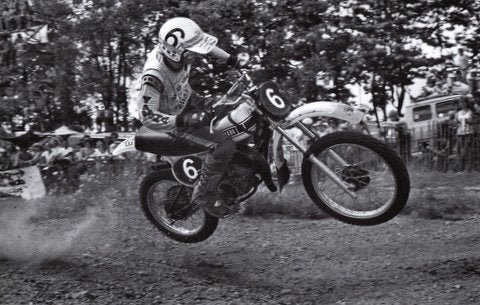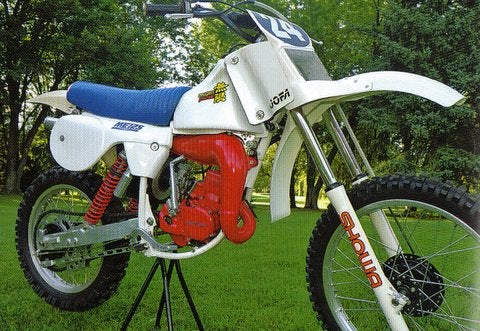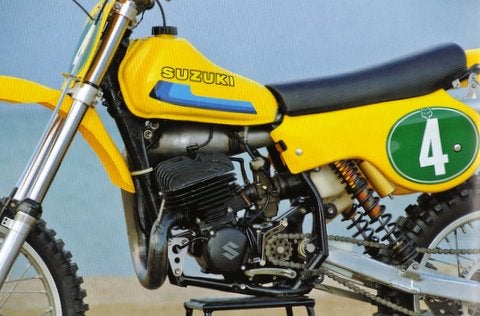 |
Legendary Motocross Bikes is more than just a 160-page coffee table book. It's one of the most important, informative, and necessary books for motorcross racing history ever produced. This thing will blow your mind, in that it has 20 of the most amazing factory works bikes ever produced, in one place, and they are all owned by the author, Terry Good.
The following bikes are featured in this book:
* 1961 Monarch/Lito
* 1971 Yamaha YZ 250
* 1972 Suzuki RH 72
* 1973 Suzuki RN73
* 1973 Yamaha YZ637
* 1974 Yamaha OW13
* 1976 Honda RC 500M
* 1976 Puch MC400
* 1976 Yamaha OW27
* 1977 Honda RC 500M
* 1979 Honda RC 250M
* 1979 Yamaha OW40
* 1980 Mugen ME125W1
* 1980 Suzuki RH 80
* 1980 Yamaha OW41
* 1981 Honda RC 250M
* 1985 Honda RC 500M
* 1986 Honda RC 250M
* 1987 Honda RC 250M
* 1989 Honda RC 500M
 |
|
Here's Joel Robert at the Czechoslovakian Grand Prix when its frame broke in half on the factory works Suzuki. Somehow, Joel nursed it home for a second-place finish. The only thing left holding the bike together was the clutch cable. |
The one thing that drives you crazy about this fantastic book is that there are so many Hondas in here, especially near the end, that it makes you wonder if there were any other bikes out there at the time.
The absence of the European bikes is especially notable. There's not one single Husky, CZ or Maico in the entire book. To forget, or not include, these important bikes in motocross history is almost unforgivable.
 |
| Roger DeCoster on the Suzuki RN 73 at the Motocross des Nations in Switzerland. |
However, author Terry Good had to deal with a publisher who shortened the book dramatically, and he decided to put the emphasis on the Japanese works bikes of that era. The book should have almost been entitled Legendary Japanese Motocross Works Bikes. The only European bikes included in this book are the Monarch Lito and the Puch MC 400.
 |
| Here's a close look at the first YZ monoshock rear suspension that ruled the world in 1973. While the welding and fabrication looked cobby, it worked better than anything else out there at the time. |
Still, a phenomenal job was done covering the bikes that are in this fantastic volume. There are bits of information that have remained unknown until this day. Also, Terry has included detailed comments about the various bikes from the people who actually raced them. Yes, that's right, you get an insight from Joe Robert, Roger DeCoster, Pierre Karsmarkers, Bob Hannah, Jim Pomeroy, Marty Tripes, Hakkan Anderson, Kent Howerton, Rick Burgett, Johnny O’Mara, Andre Malherbe, Eric Geboers, and many others.
PAGE 2
 |
| This is the first CZ prototype monoshock frame that was built by Lucien Tilkens in 1969. It was a works 380 CZ with a Citroen car shock. |
They tell you things about the bikes that you never ever would have found out back in the day. It sort of amazes you when you find out that Suzuki had the first option for the Monoshock and turned it down in spite of Roger DeCoster telling them how great it was and what potential it had. The book even tells you how the Monoshock came about.
 |
|
Hakkan Anderrsen sits astride the 1973 250 YZ that took him to the world championship. Anderson had no idea he would be part of history when he was developing the modern shock suspension.“All we wanted to do was win the world championship,” he said. |
There is a brilliant forward by Dave Arnold, who ran many factory teams. He chronicles the transition from the European mounts to the onslaught of the Japanese factories. For example: “The first Japanese works bikes utilized clever engineering and weight efficient designs that could use very lightweight race bikes -- bikes that were often very fragile unless maintained under the watchful eye of the factory mechanic.
 |
|
The Puch 400 was unique in that the frame was made out of lightweight sheet metal. The entire bike was very light and strong; servicing the bike was very easy, since everything was in the open. |
"Not only did riders have to keep dirt and water out of the engine and gearbox, they had to ride as fast as possible, with the goal of keeping machine preservation in mind. Frames, forks, and swingarms could easily crack, bend, or break as the designs were being developed. Machine toughness and durability steadily improved over time.”
He tells you stuff in his forward that takes your breath away. In 1973, Suzuki's race winning momentum was unexpectedly ended. This Suzuki killer was a two-pronged assault from Maico, shocks that had been moved forward on the swing arm, and from Yamaha, from the revolutionary Monoshock.
 |
| Bob Hannah astride the 1976 Yamaha OW27. Bob noted: “The bike was kind of like me. It wasn’t the fastest, but it just stayed there. I might not have been the fastest rider, with his fastest lap times every week, but I had the same lap times every lap for 40 minutes. The bike was the same. The factory Hondas could out run it, but the OW27 was the same the whole race at the same speed.” |
The Maico and Yamaha both had suspension travel that was an astonishing 50 percent more than Roger’s Suzukis. This was simple math. The Suzuki would not be competitive with last year's hardware. DeCoster struggled most of the 1973 season, as he was clearly at a disadvantage. Finally, tired of getting beat, Roger and fellow Belgian GP racer Sylvain Geboers teamed up and modified the rear frame and swingarm of the Suzukis. Suddenly they had the same travel as a Maico and the Yamaha. This midseason change allowed DeCoster to narrowly defend his 500 World Title against other factory riders.
PAGE 3
 |
|
The 1977 Honda RC 500M was considered by many to be the best of the 1970s works Hondas. The late, great Jim Pomeroy rode one of these brutes. |
On page 119 of Terry Terry's book is a piece by yours truly about what it's like to ride a 1980 works Yamaha OW31 465. Yamaha never gave up their works bikes for a test ride, but in this case, Kenny Clark the Yamaha racing team manager gave me the okay to ride Rex Staten's works 465. Appropriately enough, the subhead of the piece is titled “Welcome To The World Of Too Much.” When I tested that bike, Rex insisted that I ride a stock 465 around the track first. He took my lap times and recorded them. I then got on the much more powerful 465 and proceeded to go considerably slower. It was at this point that I realized most riders could not utilize the power that a works bike delivers.
 |
|
In 1980, Mugen brought out the ME 125. It was based on a Honda, and ridden by Johnny O’Mara. The distinctive red motor and white bodywork made the Mugen a real standout. |
Probably the highlights of the book are the sections by Joel Robert, Roger DeCoster and Bob Hannah. They pulled no punches and told it like it really was.
Aside from the fact that very few European bikes are represented in this book, it still remains a brilliant work and one that every motocross rider should have in his library.
 |
|
Suzuki brought out a fantastic 250 in 1980, billed as the RH80. It was ridden to many a victory by Kent Howerton. |
About the author: Terry Good started riding way back in 1970 at the age of 14. He started racing in motocross in 1972, and then he turned pro in 1975. His career reached a zenith when he competed in the infamous 1976 125 AMA nationals. In 1978, Terry bought his first ex-factory works motocross bike, and in a sense, accumulated the most outrageous collection of factory MX bikes in the world.
Sources:
Legendary Motocross Bikes is a 160-page book with 357 color photos and 61 black and white photos. It retails for $29.99, + $5.95 for Shipping. We highly recommended it for anyone even remotely interested in the sport of motocross.
You can get it by accessing http://www.mxworksbike.com/ or from Motor Books International at http://www.motorbooks.com/


 Your Privacy Choices
Your Privacy Choices